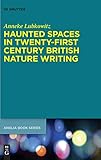Haunted Spaces in Twenty-First Century British Nature Writing / Anneke Lubkowitz.
Material type: TextSeries: Buchreihe der Anglia / Anglia Book Series ; 69Publisher: Berlin ; Boston : De Gruyter, [2020]Copyright date: ©2020Description: 1 online resource (VIII, 293 p.)Content type:
TextSeries: Buchreihe der Anglia / Anglia Book Series ; 69Publisher: Berlin ; Boston : De Gruyter, [2020]Copyright date: ©2020Description: 1 online resource (VIII, 293 p.)Content type: - 9783110678598
- 9783110678642
- 9783110678611
- 813/.6 23
- PR488.N3 L935 2020
- online - DeGruyter
- Issued also in print.
| Item type | Current library | Call number | URL | Status | Notes | Barcode | |
|---|---|---|---|---|---|---|---|
 eBook
eBook
|
Biblioteca "Angelicum" Pont. Univ. S.Tommaso d'Aquino Nuvola online | online - DeGruyter (Browse shelf(Opens below)) | Online access | Not for loan (Accesso limitato) | Accesso per gli utenti autorizzati / Access for authorized users | (dgr)9783110678611 |
Browsing Biblioteca "Angelicum" Pont. Univ. S.Tommaso d'Aquino shelves, Shelving location: Nuvola online Close shelf browser (Hides shelf browser)
Frontmatter -- Acknowledgements -- Contents -- Introduction: Nature Writing noir -- 1. Writing Nature: A Historical Survey -- 2. Haunting Nature: Place, Space and Text -- 3. The Spectropoetics of Walking: Iain Sinclair and Robert Macfarlane -- 4. De-Crypting the Gendered Outdoors with Kathleen Jamie -- 5. Unweaving Fictions of the Far North with John Burnside -- 6. Many Voices? Broadening the Vision -- Works Cited -- Index
restricted access online access with authorization star
http://purl.org/coar/access_right/c_16ec
This study investigates the figure of haunting in the New Nature Writing. It begins with a historical survey of nature writing and traces how it came to represent an ideal of ‘natural’ space as empty of human history and social conflict. Building on a theoretical framework which combines insights from ecocriticism and spatial theory, the author explores the spatial dimensions of haunting and ‘hauntology’ and shows how 21st-century writers draw on a Gothic repertoire of seemingly supernatural occurrences and spectral imagery to portray ‘natural’ space as disturbed, uncanny and socially contested. Iain Sinclair and Robert Macfarlane are revealed to apply psychogeography’s interest in ‘hidden histories’ and haunted places to spaces associated with ‘wilderness’ and ‘the countryside’. Kathleen Jamie’s allusions to the Gothic are put in relation to her feminist re-writing of ‘the outdoors’, and John Burnside’s use of haunting is shown to dismantle fictions of ‘the far north’. This book provides not only a discussion of a wide range of factual and fictional narratives of the present but also an analysis of the intertextual dialogue with the Romantic tradition which enfolds in these texts.
Issued also in print.
Mode of access: Internet via World Wide Web.
In English.
Description based on online resource; title from PDF title page (publisher's Web site, viewed 25. Jun 2024)









